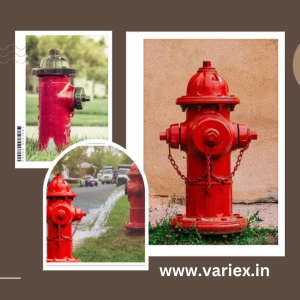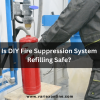![]()
Fire Immuniser
+91-7829629111
Email: info@variex.in
Varistor Technologies Pvt. Ltd.
Block-1, First Floor, Ardente Office One, Hoodi Circle, ITPL Main Road, Bengaluru, Karnataka 560048, IN
What You Need To Know About Fire Hydrant Systems
Fire hydrant systems are vital components of fire protection infrastructure, providing crucial access to water for firefighting efforts in residential, commercial, industrial, and municipal settings. Understanding the key aspects of fire hydrant systems is essential for ensuring effective fire safety measures. Here's what you need to know.
1. Components of a Fire Hydrant System:
- Fire hydrant systems typically consist of several components, including:
- Hydrants: Above-ground fixtures with outlets for connecting hoses to access water.
- Underground Piping: Pipes connecting hydrants to the water supply source.
- Valves: Control devices for regulating water flow within the system.
- Fire Department Connection (FDC): Interface for connecting fire hoses to municipal water supplies.
2. Types of Fire Hydrants:
- There are various types of fire hydrants, including:
- Wet Barrel Hydrants: Commonly used in regions with temperate climates, where the hydrant remains pressurized with water.
- Dry Barrel Hydrants: Suitable for cold climates, where water is drained from the hydrant to prevent freezing.
- Pillar Hydrants: Tall, freestanding hydrants often found in urban areas, providing easy access for firefighting personnel and equipment.
3. Operation and Maintenance:
- Fire hydrant systems require regular maintenance and testing to ensure optimal performance. Maintenance tasks may include inspecting hydrants, testing valves, flushing pipes, and verifying water pressure and flow rates.
- It's essential to establish a maintenance schedule and adhere to manufacturer recommendations and regulatory requirements to keep the system in proper working condition.
4. Importance of Location and Accessibility:
- Proper placement of fire hydrants is crucial for effective fire protection. Hydrants should be strategically located to provide maximum coverage and accessibility, considering factors such as building layout, roadways, and proximity to water sources.
- Fire hydrants must be easily identifiable and accessible to firefighting personnel and equipment during emergencies.
5. Integration with Fire Protection Systems:
- Fire hydrant systems can be integrated with other fire protection systems, such as fire alarms, sprinklers, and detection systems, to enhance overall fire safety measures.
- Integration enables coordinated response efforts and ensures rapid deployment of firefighting resources in the event of a fire emergency.
6. Regulatory Compliance:
- Fire hydrant systems must comply with relevant regulations, codes, and standards established by authorities having jurisdiction (AHJs) and industry organizations, such as the National Fire Protection Association (NFPA) and local building codes.
- Compliance with regulations ensures that fire hydrant systems meet minimum safety requirements and contribute to overall fire safety objectives.
7. Benefits of Fire Hydrant Systems:
- Fire hydrant systems offer several benefits, including:
- Rapid access to water for firefighting efforts, minimizing property damage and loss.
- Enhanced firefighting capabilities, enabling effective suppression of fires in various environments.
- Improved safety for occupants, firefighters, and surrounding communities.
- Compliance with regulatory requirements and insurance standards, reducing liability and risk.
8. Professional Expertise:
- Designing, installing, and maintaining fire hydrant systems requires specialized knowledge and expertise. It's essential to engage qualified fire protection professionals, engineers, or consultants to ensure proper system design, installation, and ongoing maintenance.
In conclusion, fire hydrant systems are essential components of comprehensive fire protection strategies, providing critical access to water for firefighting efforts. Understanding the components, operation, maintenance requirements, and regulatory considerations of fire hydrant systems is essential for ensuring effective fire safety measures and protecting lives and property from the devastating impact of fires.
Frequently Asked Questions
A fire hydrant system is a network of hydrants, pipes, valves, and connections designed to provide access to water for firefighting purposes. Hydrants are connected to a pressurized water source, typically a municipal water supply or dedicated fire protection water tank. In an emergency, firefighters connect hoses to hydrants to access water for extinguishing fires.
Fire hydrant systems are installed in various settings, including residential neighborhoods, commercial complexes, industrial facilities, municipal areas, and along roadways. They are strategically placed to provide coverage and accessibility for firefighting operations.
There are several types of fire hydrants, including wet barrel hydrants, dry barrel hydrants, and pillar hydrants. Wet barrel hydrants are pressurized with water at all times, while dry barrel hydrants are drained to prevent freezing in cold climates. Pillar hydrants are tall, freestanding hydrants commonly found in urban areas.
Fire hydrant systems should be inspected, tested, and maintained regularly according to manufacturer recommendations, regulatory requirements, and industry best practices. This typically involves periodic inspections, flow testing, lubrication of valves, and flushing of pipes.
Regulatory requirements for fire hydrant systems vary depending on local building codes, fire safety standards, and authorities having jurisdiction (AHJs). It's essential to comply with relevant regulations and standards, such as those set by the National Fire Protection Association (NFPA) and local fire departments.
Final Say
We at VariEx.in or Variexonline.com have mastered the art of designing, installing, inspecting, and fixing automatic sprinkler systems with the help of our in-house team, which is capable of delivering the fire sprinkler services you need, whether large or small and at affordable cost.
To schedule a fire sprinkler installation, or you think our services could benefit your commercial property, contact us online or give us a call at, 7829629111










